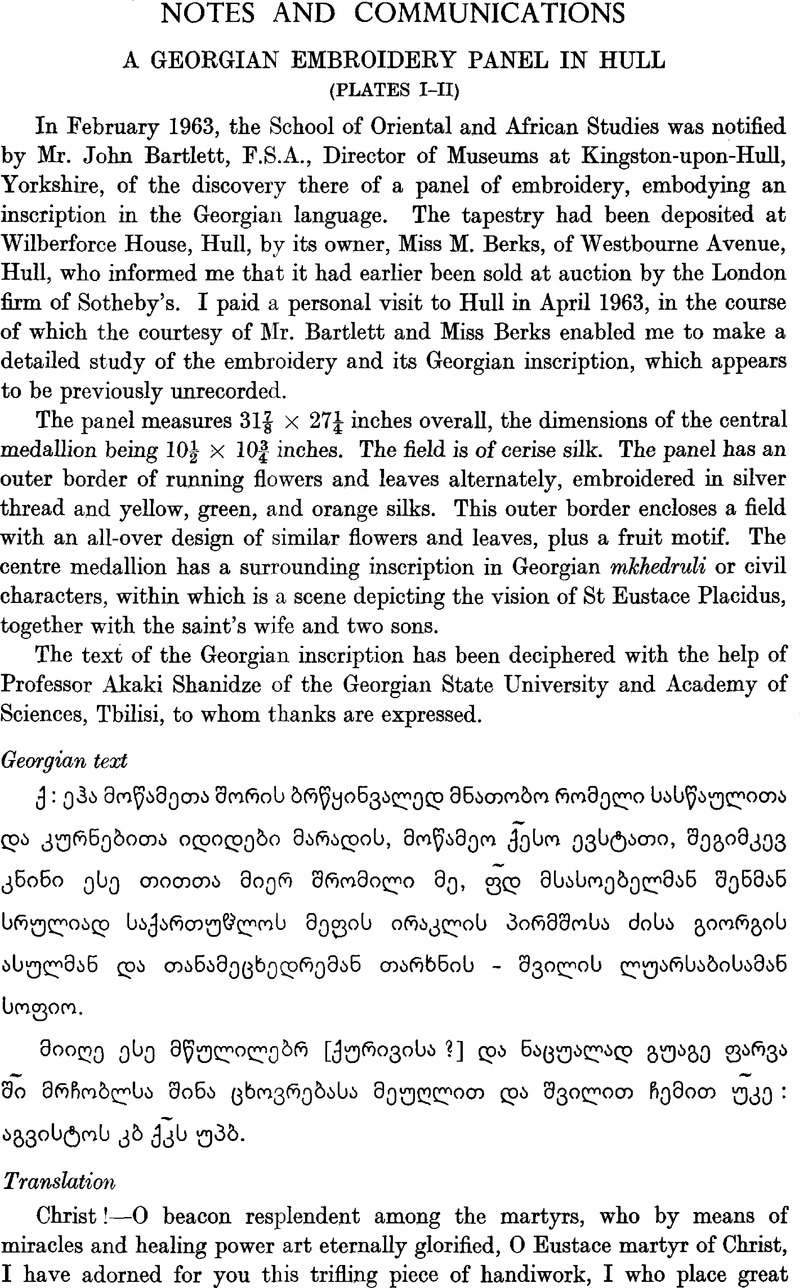No CrossRef data available.
Published online by Cambridge University Press: 24 December 2009

page 613 note 1 Brosset, M.-F., Historie de la Géorgie, II, 1, St. Petersburg, 1856, 637Google Scholar; Tumanov, Prince K. L., ‘Materialy k generlogii Bagratidov’, Novik New York, XIV, 2, 1950, 11Google Scholar.
page 613 note 2 Lang, D. M., The last years of the Georgian monarchy, New York, 1957, 255–6Google Scholar.
page 613 note 3 Sak'art'velos eklesiis kalendari 1962 dslisat'vis ‘Calendar of the Georgian Church for 1962, Tbilisi, 1961, 47Google Scholar.
page 613 note 4 Lang, D. M., Lives and legends of the Georgian saints, London, 1956, 94–114Google Scholar.
page 614 note 5 Greek and Latin texts in Acta Sanctorum, Septembris, VI, Paris, 1867, 106–37Google Scholar. Among the enormous hagiographical literature about St. Eustace Placidus, we cite here only the thorough analysis by Delehaye, H., ‘La légende de saint Eustache’, in Bulletin de la Classe des Lettres et des Sciences morales et politiques, Académie Royale de Belgique, 1919, No. 4, 175–210Google Scholar.
page 614 note 6 Garitte, G., Catalogue des manuscrits géorgiens littéraires du Mont Sinaï (CSCO, CLXV, Subsidia, IX), Louvain, 1956, p. 65Google Scholar; Garitte, G. (ed.), Le calendrier palestino-géorgien du Sinaiticus 34, Xe siècle (Subsidia Hagiographica, No. 30), Bruxelles, 1958, 91, 335Google Scholar; Kekelidze, K. S., Geschichte der kirchlichen georgischen Literatur, trans. T'arkhnishvili, and Assfalg, (Studi e Testi, No. 185), Vatican City, 1955, 476Google Scholar.
page 614 note 7 Chubinashvili, G. N., Peshchernye monastyri David-Garedzhi, Tbilisi, 1948, pp. 31–2, pl. 7 and 37.Google Scholar
page 614 note 8 Amiranashvili, Sh. Ya., Istoriya gruzinskogo iskusstva, Moscow, 1963, p. 121, pl. 116Google Scholar; Shmerling, E., Malye formy v arkhitekture srednevekovoy Gruzii, Tbilisi, 1962, pp. 62–9, pl. 2 and 3Google Scholar.
page 615 note 1 As also the comparative grammars. For the most recent treatment of some of these problems, see Allen, W. Sidney, Sandhi, 's-Gravenhage, 1962, especially pp. 95–6.Google Scholar
page 616 note 2 Where there are definite grounds for assuming the extrusion of an intervening sibilant, the Skr. sandhi is as follows (*ghs + tá =) gdhá, (*jaghs+ tá =) jagdhá, and (*babhs + tām =) babdhām; these are the only quotable examples, of which only the first two are old. They cannot be said to prove much, apart from showing that the correlation between aspiration and voice is stronger than that between aspiration and a fricative sibilant; cf. below, n. 5, and p. 617, n. 7.
page 616 note 3 A by-form of rabh.
page 616 note 4 There is considerable uncertainty between the forms of ūh and those of vah.
page 616 note 5 Even allowing that the aspiration be expressed, bh + t would be expected to yield -pth-; hence the case for the correlation. That it is ambivalent with that existing between aspiration and a sibilant fricative is demonstrated from later developments in MIA, where alternations in ‘breathy contexts’ such as Skr. sparśa = Pkt. pharṃsa, Skr. asti = Pkt. atthi occur, and in which the breathiness is expressed without voicing the consonant or group. The context is not, of course, entirely comparable with that under discussion, since, in the changes to MIA, the originating sibilant is not in interplosive position.
page 617 note 6 It is with some hesitation that the roots with medial-ṛ- are included here. In the case of dṛh and bṛh, it would be reasonable at least to assume that they might favour a solution in line with the development of tṛh, along with ūh, mih, muh, etc., and this on account of the inherent retroflexion.
page 617 note 7 Again, but for the disparity in the status of the originating sibilant, the case might be compared with the developments outlined in p. 616, n. 5. It is worth mentioning that a sandhi such as (*jaqhs + tá =) jagdhá, when compared with an external context such as (-duh-s + tatra =) -dhuk tatra, shows that the component of aspiration is a feature of the word, and has no relevance to a group in external sandhi. That the correspondence between the fricative h and *sis complete in certain contexts in Iranian hardly requires mention.
page 617 note 8 The question of occurrence of the thematic quasi-root dadha- does not arise here, but, in view of the nearly 800 occurrences in the Rigveda of finite forms from the simple verb dhā, one may marvel at the sagacity of the ancient rishis who knew to use the stem form dhad- (dhat-) only in those very forms (some 22% of the total) where a consonant sandhi would be encountered with the initial plosive (or sibilant) of an inflection. In line with the development of dhatta- is the Prākrit form of the root gra(b)h, as in, for instance, ghettūṇa, a form which presupposes *ghṛp-t-. I am grateful to Sir Ralph Turner for drawing my attention to this example.
page 618 note 9 Taking into consideration only the finite forms involves discarding the incidences of -dabdha (found only in á-dabdha) and dṛdha (but see p. 617, n. 6), involving some 50 occurrences each, together with the rarer appearance of dugdhá(9), drugdhá(2), baddha (14), and buddha (1). Once these past participles are omitted, all that is left in the Rigveda are the few forms where no aspiration is expressed in sandhi with a sibilant (type: duh + sa- = dukṣa-).
page 618 note 10 See Morgenstierne, Georg, ‘Orthography and sound-system of the Avesta’, NTS, XII, 1942, 30 ff.Google Scholar, and in particular, p. 80.
page 619 note 11 As in Latin and Germanic. Similarly -ddh- and -dd-.